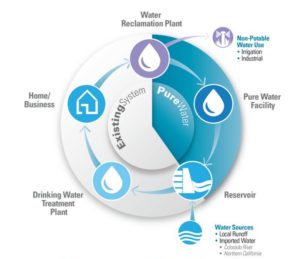Once you’ve determined that Section 106 applies to your project, then the next step is to identify any historic properties potentially affected by your project or Undertaking.
 Under 36 CFR 800.4, one starts by determining the Scope of the Identification Effort, or the Project Area of Potential Effects (APE). The Project APE consists of the horizontal and vertical limits of the project, and includes the area within which adverse effects to Historic Properties could occur as a result of the project. The Project APE subject to environmental review under Section 106 includes all areas where activities associated with the project are proposed. The APE should encompass areas proposed for construction, vegetation removal, grading, trenching, stockpiling, staging, paving, and other activities that should be thoroughly described when developing the official Project Description.
Under 36 CFR 800.4, one starts by determining the Scope of the Identification Effort, or the Project Area of Potential Effects (APE). The Project APE consists of the horizontal and vertical limits of the project, and includes the area within which adverse effects to Historic Properties could occur as a result of the project. The Project APE subject to environmental review under Section 106 includes all areas where activities associated with the project are proposed. The APE should encompass areas proposed for construction, vegetation removal, grading, trenching, stockpiling, staging, paving, and other activities that should be thoroughly described when developing the official Project Description.
The horizontal APE includes the maximum footprint of the Project on the ground surface and should represent the inventory survey coverage area for cultural resources such as archaeological sites, historic buildings and structures, as well as Tribal Cultural Resources.
The vertical APE includes the maximum depth below the surface to which excavations for project foundations and facilities will extend. Thus, it includes all subsurface areas where archaeological deposits could be affected and varies across the Project APE, depending on the type of infrastructure planned. The vertical APE also is described as the maximum height of project features, such as proposed buildings and structures, which could impact the physical integrity and integrity of setting of cultural resources, including districts and traditional cultural properties.
How does the identification process work?
Typically, the land developer, their consultant, and Federal Lead Agency first work together to conduct some preliminary desktop research. This desktop research includes activities such as requesting a records search from appropriate record holding offices, conducting a literature review of relevant previous studies conducted on the Project site or its immediate vicinity (typically a one-mile radius minimum), and carrying out local Tribal or Historic Society coordination activities to inquire about the presence of cultural resources they may have knowledge about. The APE may be adjusted based on these findings.
Second, the consultant will conduct a field site pedestrian survey of the Project APE to field check any previously identified cultural resources that were found during the desktop research and identify any new cultural resources that have the potential to be eligible for listing on the National Register of Historic Places, and thus be considered a “Historic Property”.
Once all the resources have been identified, the third step is to have the consultant evaluate their historic significance by applying the National Register criteria (36 CFR part 63) to resources identified within the Project APE that have not been previously evaluated for National Register eligibility. Once the results of the eligibility evaluation are complete, and the consultant has provided the Federal Lead Agency with documentation that includes recommendations of eligibility for each resource and an impact assessment (whether or not each potentially eligible resource will be adversely affected by the Project), the lead agency must make the final determination that the criteria have or have not been met for each resource.
Next, the Federal Lead Agency must consult with the State Historic Preservation Officer (SHPO) to ask if they agree (or concur) with the delineation of the APE and the eligibility determinations. If the SHPO concurs, the resource(s) shall be considered eligible or not eligible for the National Register for Section 106 purposes, respectively.
Lastly, if no Historic Properties will be affected by the Project, because either there are no historic properties present or there are historic properties present but the Undertaking will have no effect upon them as defined in §800.16(i), theFederal Lead Agency must provide documentation of this finding, as set forth in §800.11(d), to the SHPO, notify all consulting parties, and make the documentation available for public inspection prior to approving your project or Undertaking.
If Historic Properties will be affected by the Project, because there are historic properties which may be affected by the Undertaking, the lead agency must notify all consulting parties, invite their views on the effects, and the next step is to assess adverse effects, if any, in accordance with §800.5.
The next few posts in this series will focus on the following:
3. Assessing adverse effects to historic properties by your project
4. Resolving adverse effects to historic properties by your project
5. Other Section 106 considerations







 A previous article focused on how land managers/agencies could go about
A previous article focused on how land managers/agencies could go about  Once the Lead Federal Agency has determined that
Once the Lead Federal Agency has determined that  Once the Lead Federal Agency has
Once the Lead Federal Agency has  As of April 2017, Spindrift has been approved by the Certification Committee to obtain a Gold Shovel Standard Certification. Gold Shovel Standard (GSS) is a nonprofit organization that fills an industry gap by providing third-party confirmation of baseline Safety Management Systems for the protection of buried assets, and fair and transparent metrics for damage prevention. Gold Shovel Standard certified organizations can be recognized to be best-in-class. Learn more at:
As of April 2017, Spindrift has been approved by the Certification Committee to obtain a Gold Shovel Standard Certification. Gold Shovel Standard (GSS) is a nonprofit organization that fills an industry gap by providing third-party confirmation of baseline Safety Management Systems for the protection of buried assets, and fair and transparent metrics for damage prevention. Gold Shovel Standard certified organizations can be recognized to be best-in-class. Learn more at:  We are pleased to announce that Spindrift Archaeological Consulting (Spindrift) is an active member of ISNetworld (ISN). We have centralized our company compliance data within ISN and streamlined our reporting process, making it easier for Pacific Gas & Electric to prequalify our company and give us an “A” Grade.
We are pleased to announce that Spindrift Archaeological Consulting (Spindrift) is an active member of ISNetworld (ISN). We have centralized our company compliance data within ISN and streamlined our reporting process, making it easier for Pacific Gas & Electric to prequalify our company and give us an “A” Grade. ISN’s Review and Verification Services (RAVS) verifies and evaluates our health, safety, and procurement information to ensure regulatory and client specific requirements are met.
ISN’s Review and Verification Services (RAVS) verifies and evaluates our health, safety, and procurement information to ensure regulatory and client specific requirements are met. Under
Under